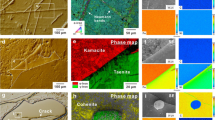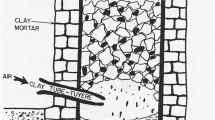Abstract
A team of students from the University of California, Berkeley, participated in a blade-smithing competition hosted by the Minerals, Metals, and Materials Society at the TMS 2015 144th annual meeting and exhibition. Motivated by ancient forging methods, the UC Berkeley team chose to fabricate our blade from historical smithing techniques utilizing naturally-occurring deposits of iron ore. This approach resulted in receiving the “Best Example of a Traditional Blade Process/Ore Smelting Technique” award for our blade named “Berkelium.” First, iron-enriched sand was collected from local beaches. Magnetite (Fe3O4) was then extracted from the sand and smelted into individual high- and low-carbon steel ingots. Layers of high- and low-carbon steels were forge-welded together, predominantly by hand, to form a composite material. Optical microscopy, energy dispersive spectroscopy, and Vickers hardness mechanical testing were conducted at different stages throughout the blade-making process to evaluate the microstructure and hardness evolution during formation. It was found that the pre-heat-treated blade microstructure was composed of ferrite and pearlite, and contained many nonmetallic inclusions. A final heat treatment was performed, which caused the average hardness of the blade edge to increase by more than a factor of two, indicating a martensitic transformation.


Similar content being viewed by others
References
J. Wadsworth, Mater. Charact. 99, 1 (2015).
O.D. Sherby and J. Wadsworth, J. Mater. Process. Technol. 117, 347 (2001).
P.L. Barnard, A.C. Foxgrover, E.P.L. Elias, L.H. Erikson, J.R. Hein, M. McGann, K. Mizell, R.J. Rosenbauer, P.W. Swarzenski, R.K. Takesue, F.L. Wong, and D.L. Woodrow, Mar. Geol. 336, 120 (2013).
S.A. Wright and D.H. Schoellhamer, San Franc. Estuary Watershed Sci. 2, Article 2 (2004).
D.H. Schoellhamer, Estuaries Coasts 34, 885 (2011).
C. Matsumoto, A.K. Das, T. Ohba, S. Morito, T. Hayashi, and G. Takami, J. Alloys Compd. 577, S673 (2013).
J. Wadsworth and D.R. Lesuer, Mater. Charact. 45, 289 (2000).
S.A. Paipetis and V. Kostopoulos, in Sci. Technol. Homeric Epics, edited by S.A. Paipetis (Springer Netherlands, Dordrecht, 2008), pp. 181–203.
R.W. Buzzard, Bur. Stand. Res. Paper No RP-605 (1933).
R.A. Grange, C.R. Hribal, and L.F. Porter, Metall. Trans. A 8, 1775 (1977).
Acknowledgements
We would like to acknowledge The Minerals, Metals, and Materials Society for hosting the 2015 Bladesmithing competition.
Author information
Authors and Affiliations
Corresponding authors
Rights and permissions
About this article
Cite this article
Vo, H., Frazer, D., Bailey, N. et al. Characterization of a Viking Blade Fabricated by Traditional Forging Techniques. JOM 68, 3174–3179 (2016). https://doi.org/10.1007/s11837-016-2109-5
Received:
Accepted:
Published:
Issue Date:
DOI: https://doi.org/10.1007/s11837-016-2109-5




